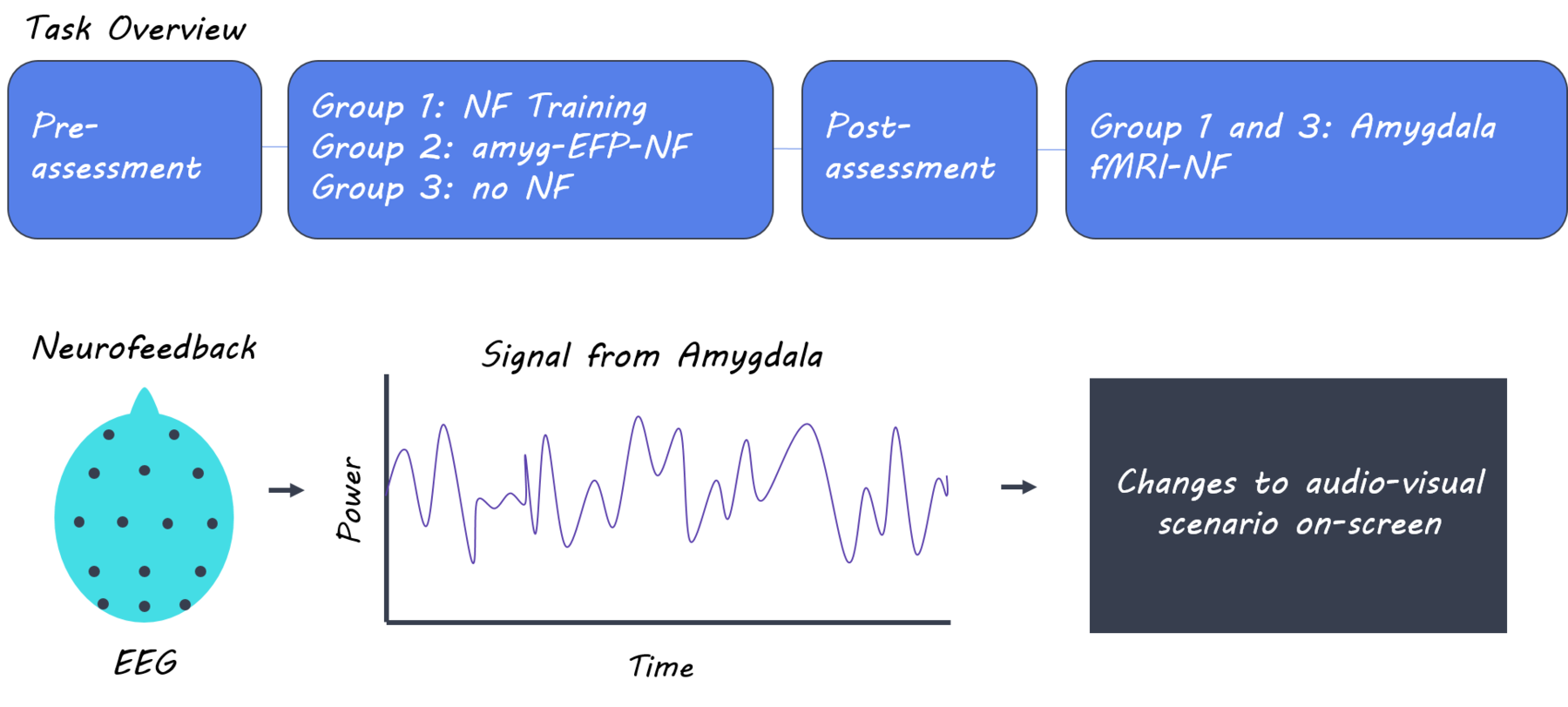Neurofeedback Training for Stress Resilience
Post by Stephanie Williams
What's the science?
Adaptive coping strategies in stressful situations have been linked to the downregulation of activity in the amygdala. Several studies have confirmed that amygdala-targeted neurofeedback can improve emotion regulation and decrease depressive symptoms. Neurofeedback is when information about an individual’s brain activity is reported to that individual in near real time, with the goal of having the person learn to alter or control their own brain activity. Despite evidence in favor of targeted neurofeedback as a method for improving strategies to cope with stress, neurofeedback using functional magnetic resonance imaging (fMRI) is not widespread due to high cost and lack of accessibility of the MRI scanner. This week in Nature Human Behavior, Jakob Keynan from Talma Hendler's lab at Tel Aviv University and Medical Center and colleagues administered and demonstrated the efficacy of a highly scalable fMRI-informed electroencephalography (EEG) neurofeedback short training protocol (coined ‘Amygdala-Electrical FingerPrint-NF’ or ‘amyg-EFP-NF’) for individuals undergoing stressful military training.
How did they do it?
The authors administered a neurofeedback training program to a large group of young men who were beginning combat training. Participants were randomly assigned (administration was double-blinded) to one of three groups: 1) neurofeedback based on an amygdala specific signal (amyg-EFP-NF), 2) control neurofeedback based on the alpha/theta ratio signal (control-NF), or 3) no neurofeedback. The authors assessed several emotion-related traits in participants (e.g. state anxiety levels, cognitive processing and emotional expression (alexithymia), which is heightened following traumatic stressors). The authors used an emotional Stroop task (eStroop) to assess emotion regulation. Participants saw a series of faces express either a fearful or happy emotion paired with a word (eg.’happy‘ or ‘fearful’). The participant’s goal was to ignore the words and correctly report the emotion they observed on the face.
Participants in the two neurofeedback groups completed six neurofeedback training sessions over four weeks while undergoing demanding military combative training on their base. Sessions involved a feedback interface: a 3D animated scenario in which avatar figures in a hospital waiting room were either agitated, speaking in raised voices, or were resting in a chair quietly. Participants first passively watched a noisy scenario with agitated avatars (the “attend” section), and then actively tried to relax the scene (the “regulate” section). Participants were instructed to find a mental way to make the figures in the animation sit down and lower their voice.
The authors used an Amyg-EFP model that had been previously developed using simultaneous EEG and fMRI recordings to predict activity in the amygdala from EEG signals. During neurofeedback trials, the authors calculated either the participant’s alpha/theta power (control-NF group) or the participant’s Amyg-EFP online during the task (amyg-EFP-NF group), and used the results of the calculation to modify the audio-visual scenario in near real time. Participants in the control-NF group learned to down-regulate their alpha/theta ratio. Participants in the Amyg-EFP group learned to down-regulate activity that was localized to the amygdala.
The authors also added an additional interference component into the task where participants had to continue to down-regulate the targeted brain activity they had learned to modify, during a cognitively demanding task. The authors also tested the participant’s ability to regulate the target brain activity (alpha/theta or amyg-EFP) without feedback. They compared the Amyg-EFP signal in both neurofeedback groups during the no feedback trials to investigate whether participants who had trained to control the Amyg-EFP signal could still willfully control Amyg-EFP without feedback. The authors also performed a one-month fMRI follow-up on participants from theAmyg-EFP-NF and no-NF groups to investigate whether participants could down-regulate amygdala BOLD activity (i.e. signal detected using fMRI) during a new neurofeedback task. This task was selected to ensure that results were transferable to different contexts.
What did they find?
The authors found that the participants who received the amyg-NF training showed lower alexithymia scores and better performance on the eStroop tasks than participants who received control-NF training, which suggests the Amyg-EFP-NF selectively modified participant’s emotion regulation. Participants in the Amyg-EFP-NF group showed significant improvement in down-regulating the Amyg-EFP signal by the fourth session and the improvement was correlated with lower alexithymia scores following NF training. As the authors hypothesized, participants in the control neurofeedback group did not show a similar down-regulation of the Amyg-EFP signal, but did show significant down-regulation of the alpha/theta ratio by the fifth session. Interestingly, each participant’s performance continued to improve with each neurofeedback session (no plateau in performance), with most participants hitting peak performance during the last session
Results from the no-feedback trials showed that the down-regulating skills participants had learned in previous sessions could be sustained in the absence of feedback. Results from the cognitive interference task showed that participants could willfully control the target signal even while carrying out a simultaneous cognitive task. The results of the one-month follow-up showed that participants from the Amyg-EFP-NF group were able to better down regulate amygdala BOLD activity than participants from the no-NF group. Participants from the Amyg-EFP-NF group also exhibited higher amygdala to ventromedial prefrontal cortex functional connectivity during the regulation period than participants from the no-NF group.
What's the impact?
Previously, the cost and mobility of fMRI neurofeedback limited the availability of neurofeedback training programs. Kenyan and colleagues successfully implemented a highly mobile and cost-effective (EEG) neurofeedback paradigm that improved emotion regulation in individuals experiencing chronic stress. The authors’ results confirm the beneficial impact of neurofeedback on emotion regulation, and show that individuals can successfully learn to volitionally regulate limbic activity and enhance their stress resilience.
Kenyan et al. Electrical Fingerprint of the Amygdala Guides Neurofeedback Training for Stress Resilience. Nature Human Behavior (2018). Access the original scientific publication here.


